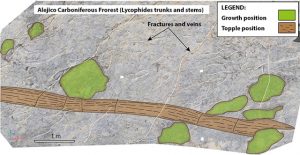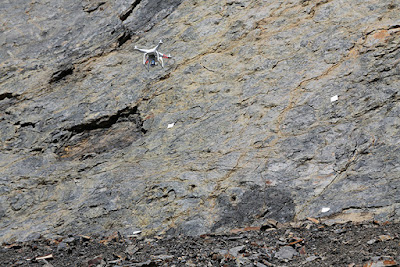
The study that we have done has a dual function. On the one hand will enable you to preserve the remains of the petrified forest where different species of trees and plants that populated our province makes 300 Ma. On the other hand, the paper provides information on the nature and the environmental conditions of this type of forests with major implications at the scientific level and educational.
In this case we have used new technological tools as the drones to obtain three-dimensional models to analyze in detail the characteristics of fossils and above all, monitoring the outcrop, with a view to its future preservation.
To be a mountain area, where the climatic conditions play a very important role in the conservation status of the outcrop, affected by a strong process of weathering and human action (as the spoliation), it was necessary to carry out this study. In the last 5 years has greatly deteriorated the outcrop, losing some remains of great scientific value for the diversity of its remains and the amount of information they provide. For example, in the outcrop are distinguished fossil remains of trees that came to exceed a height of 15 m. Some have been preserved integers in position lying while can still be distinguished remains such as stumps and roots of the same in position of life.
The drones have allowed to work in one of the slopes in which are located the fossils that are available almost vertical and several meters of height, difficult to access another way. In addition, allowed the elaboration of models textured that provide information about the size and geometry of the debris, facilitating the taking of specific measures to facilitate their description.
The area is located outside of the Park of the Picos de Europa and presents no directive of preservation, we decided to make this work to be able to have a record that allows to take future actions for its preservation. The results will also allow its use for educational outreach, since we have obtained a model fotorealístico that allows you to view Fossils preserved in the rock from any angle and perspective, facilitating their interpretation by the public.
Abstract
The Alejico coalbeds represent a well-preserved Carboniferous fossils site characterised by the presence of tree trunks in life position and parallel to bedding. The area, located near the Picos de Europa National Park (Spain), between the León and Asturias provinces, lacks of any kind of preservation directives, thus being influenced by weathering, erosion and anthropogenic destruction. We present a photogrammetric study carried out through terrestrial and UAV-assisted technology in order to collect digital 3D information for fossil analysis and future preservation. A general overview of the steep wall of the outcrop and a detailed section of the fossil forest have been implemented into a reliable and accurate point cloud. Qualitative and quantitative information was obtained from a georeferenced high-resolution digital 3D model used for the characterisation of the different outcrop features, which aimed specially at the fossil conservation. The results provide useful information on the nature and paleoenvironment of carboniferous forests with important implication for scientific and educational interests. These technologies provide new possibilities for better preservation and diffusion of geologic heritage locations prone to be damaged, and enables public awareness for the protection of fossil sites with high scientific and cultural value.
Photo




Video
Reference:
Javier Fernández-Lozano, Gabriel Gutiérrez-Alonso. The Alejico Carboniferous Forest: a 3D-Terrestrial and UAV-Assisted Photogrammetric Model for Geologic Heritage Preservation. DOI: 10.1007/s12371-016-0193-0
Note: The above post is reprinted from materials provided by Javier Fernández Lozano.

















